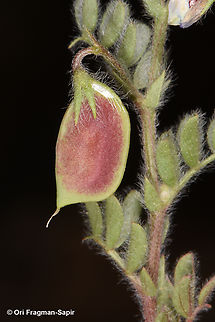
Naming
Many different names in different parts of the world are used for the crop lentil. The first use of the word "lens" to designate a specific genus was in the 16th century by the botanist Tournefort. The word "lens" for the lentil is of classical Roman/Latin origin: McGee points out that a prominent Roman family took the name "Lentulus", just as the family name "Cicero" was derived from the chickpea, "Cicer arietinum", or "Fabia" from the fava bean.Reproduction
Although lentils have been an important crop for centuries, lentil breeding and genetic research have a relatively short history compared to that of many other crops. Since the inception of The International Center for Agriculture Research in the Dry Areas breeding programme in 1977 significant gains have been made. It supplies landraces and breeding lines for countries around the world, supplemented by other programmes in both developing and developed countries. In recent years, such collaborations among breeders and agronomists are becoming increasingly important.The focus lies on high yielding and stable cultivars for diverse environments to match the demand of a growing population. In particular, progress in quantity and quality as well as in the resistance to disease and abiotic stresses are the major breeding aims. Several varieties have been developed applying. Serious genetic improvement for yield has been made, however, the full potential of production and productivity could not yet be tapped due to several biotic and abiotic stresses.
Wild "Lens" species are a significant source of genetic variation for improving the relatively narrow genetic base of this crop. The wild species possess many diverse traits including disease resistances and abiotic stress tolerances. The above-mentioned "L. nigricans" and "L. orientalis" possess morphological similarities to the cultivated "L. culinaris". But only "L. culinaris" and "L. culinaris" subsp. orientalis are crossable and produce fully fertile seed. Between the different related species hybridisation barriers exist. According to their inter-crossability "Lens" species can be divided into three gene pools:
# Primary gene pool":" "L. culinaris" and "L. odemensis"
# Secondary gene pool: "L. ervoides" and "L. nigricans"
# Tertiary gene pool: "L. lamottei" and "L. tomentosus"
Crosses generally fail between members of different gene pools. However, plant growth regulators and/or embryo rescue allows the growth of viable hybrids between groups. Even if crosses are successful, many undesired genes may be introduced as well in addition to the desired ones. This can be resolved by using a backcrossing programme. Thus, mutagenesis is crucial to create new and desirable varieties. According to Yadav et al. other biotechnology techniques which may impact on lentil breeding are micro-propagation using meristamatic explants, callus culture and regeneration, protoplast culture and doubled haploid production.
There is a proposed revision of the gene pools using SNP phylogeny.
Evolution
The cultivated lentil "Lens culinaris" subsp. "culinaris" was derived from its wild subspecies "L. culinaris" subsp. "orientalis", although other species may also have contributed some genes, according to Jonathan Sauer Unlike their wild ancestors, domesticated lentil crops have indehiscent pods and non-dormant seeds.Lentil was domesticated in the Fertile Crescent of the Near East and then spread to Europe, the Middle East, North Africa and the Indo-Gangetic plain. The primary center of diversity for the domestic "Lens culinaris" as well as its wild progenitor "L. culinaris ssp. orientalis" is considered to be the Middle East. The oldest known carbonized remains of lentil from Greece's Franchthi Cave are dated to 11,000 BC. In archaeobotanical excavations carbonized remains of lentil seeds have been recovered from widely dispersed places such as Tell Ramad in Syria, Aceramic Beidha in Jordan, Hacilar in Turkey, Tepe Sabz in Iran and Argissa-Magula Tessaly in Greece, along other places.
References:
Some text fragments are auto parsed from Wikipedia.